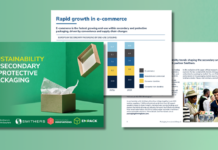MÜLLER Yogurt & Desserts is to roll out NaviLens codes across all its branded products to increase accessibility for blind and partially sighted people.
The move, which it said is a first for the UK dairy sector, is deemed by the brand as being ‘integral’ in its social commitment to help consumers live ‘happier, healthier’ lives, and make the dairy category more inclusive and accessible for all consumers.
NaviLens is an award-winning app technology which sees a high-contrast colour code printed on product packaging that is detectable by a smartphone camera from up to 12x farther than a QR code and with a wide reading angle of up to 160o – meaning users do not need to know precisely where the code is located to scan it.
Dedicated NaviLens codes printed on Müller products can be scanned using the corresponding app, with audio and haptic cues allowing users to locate and centre the code in the smartphone’s camera. Depending on shopper preferences, the app can either read aloud the ingredients, allergens, nutrition, and recycling information for the product, or the user can read the information on their phone using accessibility tools.
The initiative has been informed by Sight Loss Councils (SLCs). The regional groups of blind and partially sighted volunteers funded by Thomas Pocklington Trust. Volunteers have used their lived experience of sight loss to inform the accessibility of the packaging.
The technology will be rolled out across all Müller Yogurt & Desserts products and drinks over the coming months – starting with the newly relaunched Müller Light range this month.
Richard Williams, chief executive officer of Müller Yogurt & Desserts, said, “Making a positive social impact and helping to create stronger and more inclusive communities is a key part of Müller’s wider sustainability action plan. We want to play our part in helping people lead healthier and happier lives, and being the first in the industry to partner with NaviLens is key in achieving that goal.
“The innovative and lifechanging technology offered by NaviLens helps those with visual impairments overcome issues which others may never consider. By working with NaviLens, and raising awareness through our upcoming campaign, we hope to help encourage inclusivity, make the category more accessible for all shoppers, and ensure we achieve our purpose of putting a smile on the nation’s face.
“By playing our part in building a better future, this move will also help us continue to drive category growth for our customers, and reignite the core of our Müller Yogurt & Desserts range.”
Louise Connop, SLC senior engagement manager at Thomas Pocklington Trust, added, “We are proud of our partnership with Müller and our SLC volunteers to inform and increase the accessibility of packaging, to make their products more accessible for BPS people.
“As a person living with sight loss, accessible packaging means the difference between understanding what a product is and any potential allergens versus being unable to shop independently and pick products in the store on my own. Instead I can simply now scan the packaging with my smartphone which will recognise and tell me about the product and its ingredients easily using the app.”
Chief executive officer of NaviLens, Javier Pita, commented, “We are thrilled to partner with Müller to integrate our technology into their product packaging. This collaboration demonstrates our mutual commitment to enhancing accessibility and providing an inclusive, and informative shopping experience for all consumers.
“By placing NaviLens accessible codes on Müller products, we are empowering blind and partially sighted individuals to access crucial product information independently, while also enriching the overall shopping experience for everyone.
“It has been a joy to work with the Müller team on this project, their enthusiasm and attention to detail is second to none, and ultimately this partnership marks a significant step forward in setting new standards for accessibility and consumer engagement in the retail industry.”














